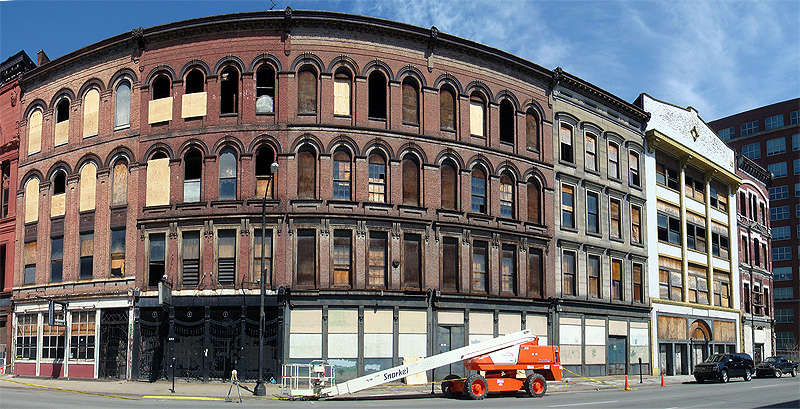Preservation Louisville and the Louisville Historical League will be hosting a walking tour of the Iron Quarter block threatened with demolition in Downtown. The groups will meet Sunday, May 16 at 2:00 PM at the parking garage at First and Main Streets.
Admission is free for members of either organization, but anyone can go and sign up at the event. Individual membership is $35 for Preservation Louisville and $20 for the Louisville Historical League. Membership for students and seniors is $15 for both.
Progress on the efforts to save the buildings will be discussed along with the history of the block. Here’s some info from the press release:
Members of Preservation Louisville, Inc. and the Louisville Historical League will gather to take a walking tour of the 100 Block of West Main Street, called “Whiskey Row” in downtown Louisville. Whiskey Row is a historic row of attached buildings built approximately between 1852 and 1905. Architects include Henry Whitestone, John Andrewartha (City Hall) and D. X. Murphy (Churchill Downs). The Whiskey Row district is one of the most popular and well-known areas of Louisville Metro and currently 7 of the buildings on the block are in danger of demolition.



Also check out the new LouHI topic "Effort to Preserve the Iron Quarter / Historic Whiskey Row Buildings Needs Money to File Landmark Applications"
http://www.historyandissues.org/louisville/viewto…
By the way, what a cool photo!!
Thanks, Steve. Keep up the good work covering this really important issue.
I can't wait Iron Quater get under const.
Happened to catch a revealing interview with Bill Weyland and Stephen Porter regarding the Iron Quarter saga on 84 WHAS this morning… I thought it was a smart discussion, except that is, for the constant interjection from the radio personality. The theme I heard through the interview was that the development of this block will require a particular sensitivity.
Louisvillian’s for many years have come to appreciate these buildings and look over-beyond-other buildings. Casual observers are keen to the value of any structure found in the environment. Louisville’s historic structures have value in their being, and what they housed in their history. Not simply for their location. We tell stories by what was there, or who we know from our family’s or nation’s history associated with that building. We don’t fondly recount the succession of grocers located on the corner of two highways in a graying cinderblock building. What stories do we tell or do we even look up? Why is that important? I believe the individual must recognize their role as owner as steward, or observer as steward. Sensitivity.
“What [moneys] have Historic Preservationists brought to the table?†I think that question was answered skillfully in the interview.